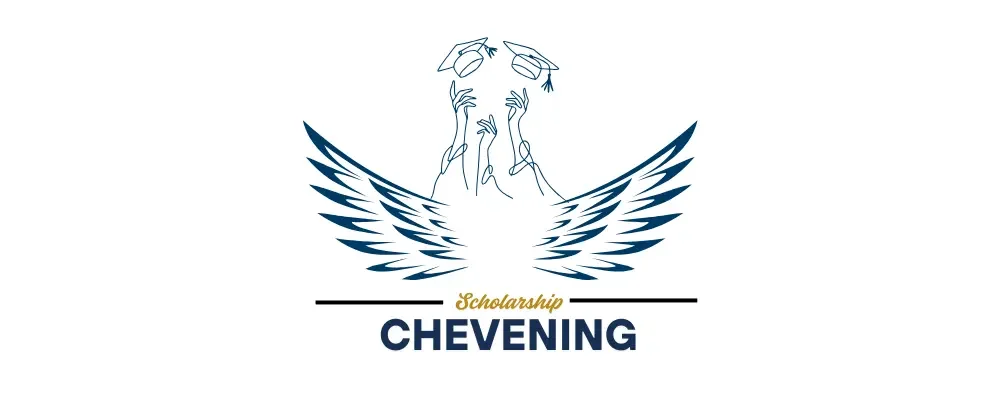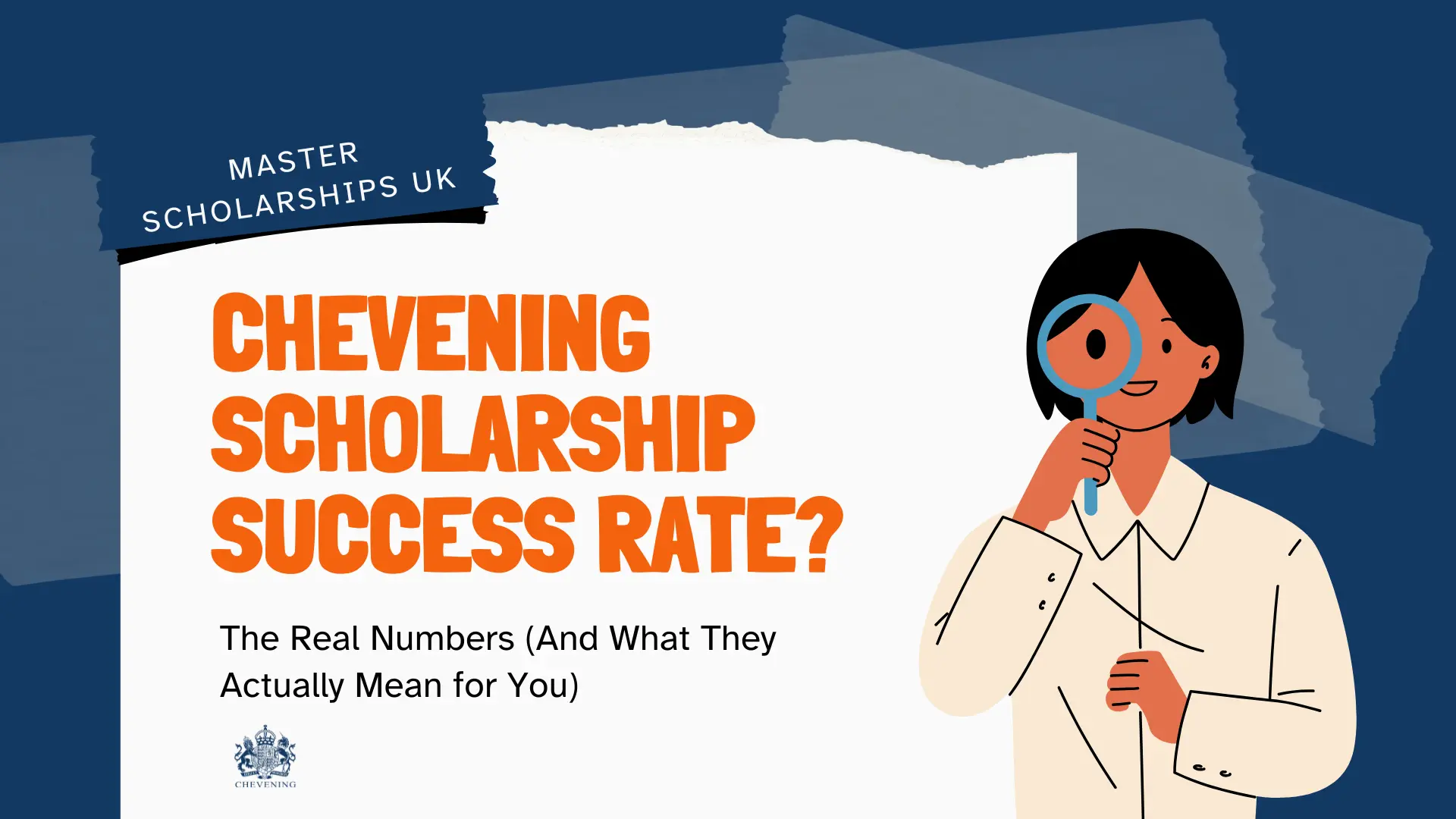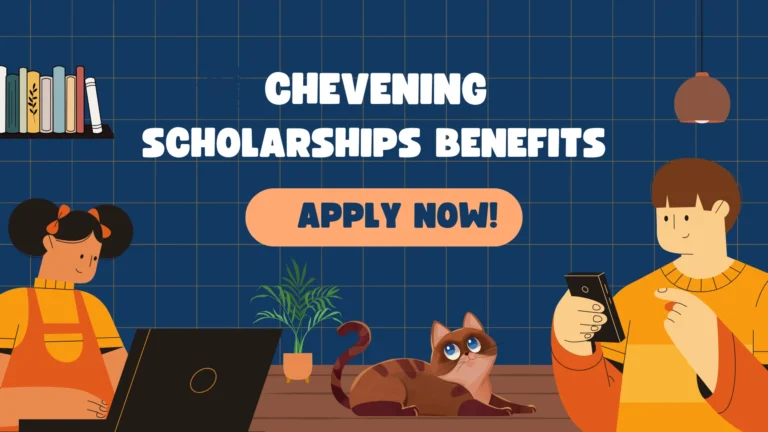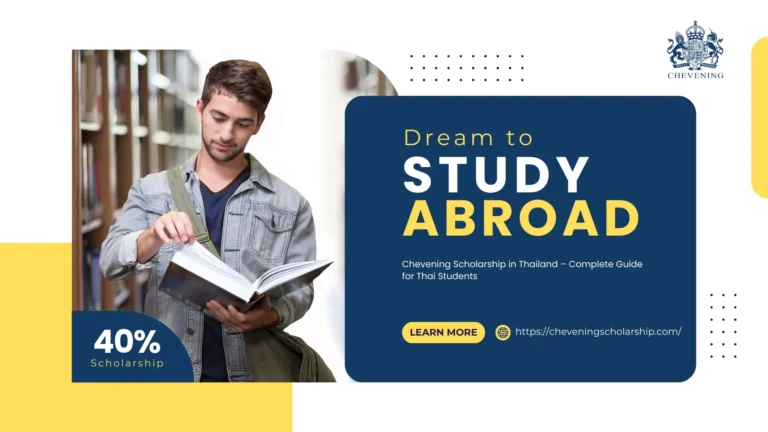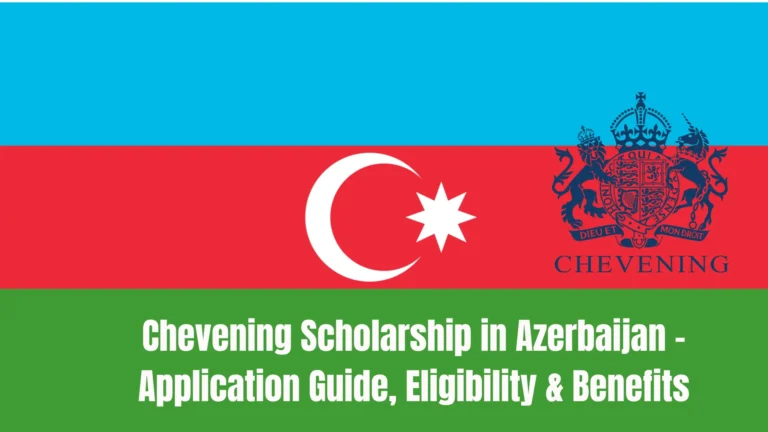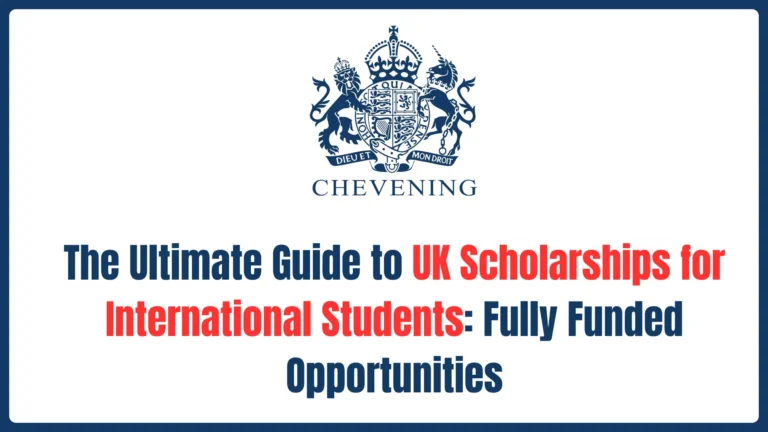Chevening Scholarship Success Rate: The Real Numbers (And What They Actually Mean for You)
Let’s start with the number everyone wants to know but is afraid to google: 2.5%
That’s the Chevening scholarship success rate. Out of roughly 60,000 global applications each year, about 1,500 scholarships are awarded.
To put that in perspective: you’re statistically more likely to get into Harvard, Stanford, or Oxford undergrad than to win Chevening. Those schools hover around 3-5% acceptance rates. Chevening? Lower.
Now, before you close this tab and abandon your dreams, let me tell you what that 2.5% doesn’t capture: the quality of applications varies wildly. Many applicants don’t meet basic requirements. Many submit last-minute, poorly prepared applications. Many don’t even make it past the first screening.
The Chevening scholarship acceptance rate for well-prepared, strategic applicants is significantly higher than 2.5%. We’re talking potentially 10-15% or better if you understand what you’re doing.
So this isn’t about scaring you. It’s about understanding the real landscape so you can compete intelligently. Let’s break down exactly what the Chevening scholarship success rate looks like at each stage, what factors affect your odds, and how you can position yourself in that successful minority.
The Numbers: Breaking Down Chevening Scholarship Statistics
The Overall Picture
Chevening scholarship statistics for a typical year:
| Stage | Number | Percentage | Your Odds |
|---|---|---|---|
| Applications Received | ~60,000 | 100% | – |
| Eligible Applications | ~50,000 | 83% | 1 in 1.2 (if you meet requirements) |
| Shortlisted for Interview | ~8,000-10,000 | 13-17% | 1 in 6-8 |
| Final Scholarships Awarded | ~1,500 | 2.5% | 1 in 40 overall |
| Rejected | ~58,500 | 97.5% | – |
What These Numbers Actually Mean
The 17,000 who don’t meet basic requirements: These are applications that:
- Don’t have required work experience
- Missing documentation
- Submitted after deadline
- From ineligible countries
- Don’t meet educational requirements
If you’re eligible and complete a proper application, you’re already ahead of ~17% of applicants.
The ~40,000 who meet requirements but aren’t shortlisted:
- Generic, template-based applications
- Weak essays without specific examples
- Poor demonstration of leadership
- Vague career plans
- References submitted late or not at all
- No clear fit with Chevening values
The ~8,000 who are shortlisted but not selected: These are genuinely competitive candidates. The difference here is often:
- Interview performance
- Specific strategic priorities
- Cohort balance considerations
- Fine margins on overall assessment
Critical insight: Getting shortlisted is the hardest barrier. Chevening scholarship shortlisting rate is 13-17%. But once shortlisted, your Chevening interview success rate jumps to 15-20%.
Your odds improve dramatically if you make it to interviews.
Success Rates by Country: Geography Matters
Chevening Acceptance Rate by Country
Chevening scholarship acceptance rate varies significantly by country. Here’s why:
High-competition countries (0.5-1% acceptance):
- Pakistan: 5,000-7,000 applications, 30-40 awards
- India: 4,000-5,000 applications, 30-35 awards
- Nigeria: 3,000-4,000 applications, 25-30 awards
- Bangladesh: 2,000-3,000 applications, 15-20 awards
Chevening scholarship acceptance rate Pakistan: Roughly 0.5-0.8% Chevening scholarship acceptance rate India: Roughly 0.6-0.9%
Medium-competition countries (2-4% acceptance):
- Kenya: 2,000 applications, 40-50 awards
- Ghana: 1,500 applications, 30-35 awards
- Egypt: 1,800 applications, 40-45 awards
- Indonesia: 1,500 applications, 30-35 awards
Lower-competition countries (5-10% acceptance):
- Small island nations
- Post-conflict countries
- Countries with smaller applicant pools
- Strategic priority countries
Why this variation?
- Population size: Larger countries = more applicants
- English proficiency: Countries with strong English education systems see more applicants
- Scholarship awareness: Some regions have better knowledge of Chevening
- Historical ties: Commonwealth countries tend to have higher application rates
- Strategic priorities: UK has specific relationships with certain countries
What this means for you: You’re not competing globally—you’re primarily competing against applicants from your country or region. Understanding your specific competition landscape matters.
Regional Success Patterns
Chevening scholarship success rate by region:
| Region | Typical Applications | Typical Awards | Acceptance Rate |
|---|---|---|---|
| South Asia | 12,000-15,000 | 120-150 | 0.8-1.2% |
| Sub-Saharan Africa | 15,000-18,000 | 400-450 | 2.5-3% |
| Middle East & North Africa | 8,000-10,000 | 200-250 | 2.5-3% |
| Latin America | 5,000-6,000 | 150-180 | 2.5-3.5% |
| East Asia & Pacific | 8,000-10,000 | 250-300 | 2.8-3.5% |
| Europe & Central Asia | 3,000-4,000 | 150-180 | 4-5% |
Note: These are estimates based on available data and may vary year to year.
Success Rates by Stage: Where Do People Fail?
Stage 1: Application Screening
Chevening scholarship application success rate at initial screening:
Pass rate: 13-17%
Why applications fail here:
1. Eligibility issues (60% of rejections)
- Insufficient work experience (can’t document 2,800 hours)
- Don’t meet educational requirements
- Citizenship issues
- Previously studied in UK with government funding
2. Application quality issues (30% of rejections)
- Generic essays without specific examples
- Weak leadership demonstration
- Vague career plans
- Poor writing quality
- Late or missing references
- No clear Chevening fit
3. Technical issues (10% of rejections)
- Incomplete applications
- Missing documentation
- Deadline violations
- Reference submission failures
What improves your odds at this stage:
- Start early (3-6 months before deadline)
- Specific, evidence-based essays
- Strong, submitted references
- Clear Chevening values alignment
- Professional presentation
- Strategic university choices
Stage 2: Interview Shortlisting
Chevening scholarship interview competition rate:
From 50,000 eligible to 8,000-10,000 shortlisted = 16-20% pass rate
What determines shortlisting:
- Combined essay scores
- Leadership evidence strength
- Career plan clarity
- Overall application coherence
- Reference quality
- Strategic fit with country priorities
The shortlisting is the hardest gate. Most competitive applicants who don’t make it fail here, not at interview.
Stage 3: Interview Performance
Chevening interview success rate: 15-20%
From 8,000-10,000 interviewed to 1,500 selected
Chevening scholarship interview pass rate is significantly better than overall acceptance rate.
Why people fail interviews:
- Can’t articulate application claims (exaggerated in essays)
- Poor communication skills
- Weak understanding of home country context
- Unclear return plans
- Can’t handle pressure or unexpected questions
- Lack authentic passion
What improves interview success:
- Thorough preparation (8+ weeks)
- Authenticity and honesty
- Clear articulation of goals
- Demonstrated cultural intelligence
- Genuine passion for work
- Grace under pressure
Chevening scholarship post-interview success: If you interview well, you have roughly 1 in 5 to 1 in 6 chance of selection. Much better than 1 in 40 overall.
What Actually Affects Your Success Rate
The Controllable Factors
Chevening scholarship tips for success based on data:
1. Application Timing
Success rates by submission timing:
- 6+ weeks early: Estimated 3-4% success (higher than average)
- 2-4 weeks early: Estimated 2.5-3% success
- Final week: Estimated 1.5-2% success (technical issues, rushed quality)
- Last day: Estimated 1% success
Why?
- Early submissions allow for revisions
- Show organization and commitment
- Avoid technical issues
- References more likely submitted
- Less stress = better quality
2. Essay Quality
Chevening scholarship essay success rate correlation:
Generic essays: ~5% shortlisting rate Specific, evidence-based essays: ~20-25% shortlisting rate
Difference makers:
- Specific examples with quantified impact
- Clear demonstration of leadership
- Authentic voice and story
- Strategic coherence across essays
- Professional writing quality
One successful scholar told me: “I wrote seven drafts of my leadership essay. Each revision cut generic statements and added specific evidence. The final version had three concrete examples with measurable outcomes. That specificity got me shortlisted.”
3. Career Plan Clarity
Chevening scholarship career plan success factor:
Vague plans (“work in development sector”): Low success Specific plans (named organizations, roles, timeline): High success
What works:
- Specific organization or ministry
- Particular role or initiative
- Timeline with milestones
- Measurable goals
- Clear connection to UK education
- Realistic understanding of home country needs
4. Leadership Evidence
Chevening scholarship leadership success impact:
Leadership evidence strength:
- Job titles alone: Weak
- Vague “led projects”: Moderate
- Specific achievements with quantified impact: Strong
- Founded/grew organizations: Very strong
- Created measurable change: Excellent
The pattern: Leadership that created demonstrable impact beats impressive titles with vague responsibilities.
5. Reference Quality
Late or weak references: Automatic disadvantage Strong, timely references: Significant advantage
Reference success factors:
- Submitted 2+ weeks before deadline
- From direct supervisors or people who know your work deeply
- Specific examples and achievements mentioned
- Corroborate your application narrative
- Professional and detailed
The Uncontrollable Factors
Things that affect success but you can’t change:
1. Country competition level You can’t control being from Pakistan vs. Fiji. But you can optimize for your specific context.
2. Year-to-year variations Some years have more applications, different strategic priorities, varying scholarship allocations.
3. Cohort balance Chevening wants diversity across:
- Fields of study
- Geographic regions within countries
- Gender
- Professional sectors
- Types of leadership experience
You might be excellent but similar to many other strong candidates.
4. Strategic priorities UK government priorities shift. Certain sectors or regions may be prioritized some years.
5. Interview panel composition Different panels have different styles and preferences.
Reapplication Success Rates
Chevening Scholarship Reapplication Rate
Can you try again? Yes. Should you? Maybe.
Chevening scholarship resubmission success rate:
- First-time applicants: 2.5% overall
- Second-time applicants: Estimated 3-4%
- Third-time applicants: Estimated 4-5%
Why reapplication success improves:
- You know the process
- You’ve strengthened your profile
- Your essays are better
- You understand what they’re looking for
- You’ve likely gained more experience
- Shows genuine commitment
Many successful scholars applied 2-3 times before winning.
When to reapply:
✓ Good reasons:
- You’ve strengthened weak areas
- Gained more work experience
- Improved leadership evidence
- Refined your career plan
- Better understanding of Chevening values
✗ Poor reasons:
- Just submitting same application again
- Hoping luck changes
- Not addressing previous weaknesses
- Still missing requirements
Reapplication strategy:
- Strengthen profile (more experience, leadership, impact)
- Completely rewrite essays
- Choose different referees if possible
- Apply to different universities
- Address any weaknesses from previous application
Comparing Chevening to Other Scholarships
Chevening Scholarship Success Rate Compared to Other Scholarships
How Chevening stacks up:
| Scholarship | Approximate Acceptance Rate | Key Differences |
|---|---|---|
| Chevening | 2.5% | UK-focused, leadership emphasis |
| Rhodes | 0.7-1% | More selective, US/Commonwealth focus |
| Gates Cambridge | 0.3% | Extremely selective, Cambridge only |
| Fulbright | 10-20% (varies by country) | US-focused, cultural exchange emphasis |
| Commonwealth | 3-5% | Similar to Chevening, development focus |
| DAAD | 15-25% | Germany-focused, more available spots |
| Erasmus Mundus | 10-20% (varies by program) | Europe-focused, multiple countries |
Chevening’s unique position:
- More selective than Fulbright or DAAD
- Less selective than Rhodes or Gates Cambridge
- Similar to Commonwealth
- Strong brand recognition
- Comprehensive benefits
- Large global network
Success Stories and Patterns
Chevening Scholarship Successful Candidates
What successful candidates have in common:
Profile patterns:
- 3-6 years progressive work experience (not just minimum)
- Clear leadership trajectory
- Specific, achievable goals
- Strong academic background (not necessarily perfect)
- Demonstrated commitment to home country
- Authentic passion for their field
Application patterns:
- Started 6+ months before deadline
- Multiple essay drafts (5-10 revisions typical)
- Strategic university choices aligned with goals
- Strong references submitted early
- Coherent narrative throughout
- Professional presentation
Interview patterns:
- Thorough preparation (mock interviews, current affairs study)
- Authentic, not performative
- Clear articulation of ideas
- Grace under pressure
- Genuine passion evident
- Specificity in all answers
Chevening scholarship success stories share these themes:
- Overcame significant obstacles
- Clear sense of purpose
- Demonstrated resilience
- Authentic connection to work
- Realistic about challenges
- Strategic about opportunities
One pattern that surprised me: Many successful scholars weren’t the “perfect” candidates on paper. They were the authentic ones with clear purpose and specific plans.
How to Improve Your Success Rate
Practical Strategies That Move the Needle
Chevening scholarship tips from winners:
Strategy 1: Start Ridiculously Early
Timeline impact on success:
- 12 months early: Build profile, gain experience
- 6 months early: Research, draft essays
- 3 months early: Refine, get feedback
- 1 month early: Finalize, submit
Why this works: Gives time to strengthen weak areas, produce quality work, reduce stress.
Strategy 2: Be Ruthlessly Specific
Generic application: Low success Specific application: High success
Specificity means:
- Named organizations and people
- Quantified achievements
- Particular challenges and solutions
- Concrete timeline and goals
- Precise connection between past, present, future
Strategy 3: Demonstrate, Don’t Declare
Declaring leadership: “I am a natural leader who…” Demonstrating leadership: “I mobilized 50 community members to build three schools in rural regions, resulting in 400 children gaining access to education…”
The second approach is dramatically more successful.
Strategy 4: Align with Chevening Values
Chevening seeks:
- Leadership (proven, not claimed)
- Networking ability (relationship-building, not just contacts)
- Academic excellence (not just grades, but application of learning)
- Return commitment (specific plans, not vague aspirations)
Successful applications explicitly demonstrate these through concrete examples.
Strategy 5: Optimize for Your Context
Chevening scholarship competitive edge comes from understanding your specific situation:
High-competition country?
- Differentiate aggressively
- Start earlier
- Over-prepare everything
- Find unique angle
Medium-competition country?
- Maintain high standards
- Don’t assume success
- Prepare thoroughly
Lower-competition country?
- Don’t get complacent
- Quality still matters
- You’re assessed globally
Strategy 6: Prepare for Interview from Day One
Don’t wait for shortlisting to prepare.
Start when you submit:
- Review application regularly
- Study current affairs
- Practice articulation
- Mock interviews
- Build confidence
Why? If shortlisted, you’ll have weeks of preparation already done. If not shortlisted, you’ve still developed valuable skills.
What the Success Rate Doesn’t Tell You
The Hidden Realities
Numbers miss important nuances:
1. Quality Variance is Enormous
Not all 60,000 applications are competitive. Many are:
- Last-minute submissions
- Missing basic requirements
- Poor quality essays
- Incomplete documentation
If you submit a complete, well-prepared application, your real competition is maybe 10,000-15,000 truly competitive applications, not 60,000.
2. Strategic Fit Matters
Even excellent candidates may not fit strategic priorities that year. This doesn’t mean you weren’t good enough.
3. Luck Plays a Role
Interview panel composition, specific questions asked, mood of the day—random factors influence outcomes more than we’d like to admit.
4. Rejection Doesn’t Mean Failure
97.5% are rejected. Many go on to:
- Win other prestigious scholarships
- Excel in their careers
- Create significant impact
- Try again and succeed
Chevening rejection isn’t a judgment of your worth or potential.
The Psychological Impact of Success Rates
How to think about the 2.5%:
Unhelpful mindset: “Only 2.5% succeed, so I probably won’t. Why bother?”
Helpful mindset: “2.5% succeed, which means 1,500 people. Those people aren’t superhuman. With strategic preparation, I can be one of them. And even if not, the preparation itself has value.”
Remember:
- 1,500 scholarships awarded annually
- Those people were once in your position
- They faced the same odds
- Many tried multiple times
- Strategic approach significantly improves odds
- Preparation has value regardless of outcome
Regional and Demographic Patterns
Success Rate Variations
Chevening scholarship success rate by course:
No significant variation by field of study. Chevening funds all disciplines. Success depends on quality of application, not subject choice.
Slight advantages in:
- Development-related fields (aligned with Chevening mission)
- Public policy and governance
- Fields addressing home country priority needs
But this is marginal. Strong applications succeed regardless of field.
Gender patterns:
- No significant gender preference in selection
- Women slightly underrepresented in applications in some countries
- When women apply with strong profiles, success rates are comparable
Age patterns:
- Most successful scholars are 25-35 years old
- This reflects work experience requirements
- No maximum age limit
- Mature candidates with strong profiles succeed
Professional sector patterns:
- Public sector: Common
- Non-profit/NGO: Common
- Private sector: Less common but increasing
- Entrepreneurship: Growing representation
The key: Demonstrate how your sector work creates impact, regardless of sector.
The Bottom Line on Success Rates
Chevening scholarship success rate of 2.5% tells you:
What it means:
- Competition is real and intense
- Strategic preparation is essential
- Quality over rushing matters
- Multiple factors influence outcomes
- Rejection is statistically normal
What it doesn’t mean:
- You shouldn’t apply
- Only “perfect” candidates succeed
- Your odds can’t improve
- Preparation doesn’t matter
- Rejection reflects your worth
The Real Success Rate That Matters
For well-prepared, strategic applicants:
- Who meet all requirements clearly
- Who start early and prepare thoroughly
- Who demonstrate genuine Chevening fit
- Who submit specific, evidence-based applications
- Who prepare extensively for interviews
Your effective success rate is probably 10-15%, not 2.5%.
That’s still competitive, but it’s far more achievable than the raw numbers suggest.
Your Personal Success Rate
Factors that increase YOUR odds:
✓ Meeting requirements with documentation to prove it ✓ Starting 6+ months before deadline ✓ Specific, quantified achievements in essays ✓ Clear career plan with named organizations ✓ Strong, timely references ✓ Strategic university choices ✓ Thorough interview preparation ✓ Authentic passion and purpose ✓ Resilience and willingness to try again if needed
Each factor you optimize moves your personal success rate higher.
Final Perspective: Beyond the Numbers
Here’s what matters more than success rates:
The application process itself has value:
- Clarifies your goals
- Improves self-presentation
- Develops strategic thinking
- Creates professional documents
- Builds confidence
- Opens other opportunities
Many “unsuccessful” applicants report: “I didn’t get Chevening, but the preparation helped me win [other scholarship/job/opportunity]. The process was worth it.”
The scholarship changes lives, but so does the journey toward it.
Chevening scholarship transparency in success rates is limited—they don’t publish detailed statistics. But the patterns are clear:
- Strategic preparation matters
- Quality beats quantity
- Persistence often wins
- Your story and fit matter more than perfection
- The 2.5% are real people who started where you are
You can be one of them.
Planning to apply for Chevening? What concerns you most about the success rates? Share in the comments and let’s discuss strategies.
Past applicants (successful or not): What would you tell someone worried about the 2.5%? Your perspective helps.
Remember: 1,500 people win Chevening annually. They all faced the same statistics. They all wondered if they’d be in the 2.5%. They applied anyway. Some succeeded. Some tried again. Some found other paths. All grew from the experience.
Your journey starts by trying. The success rate only matters if you’re in the game.
